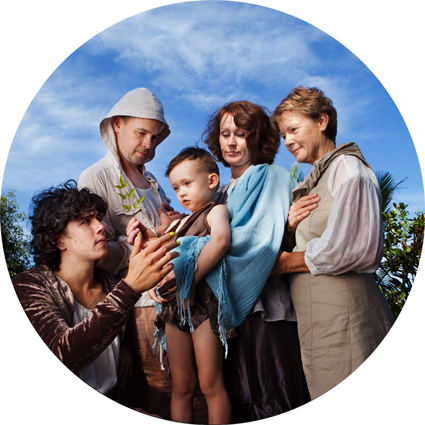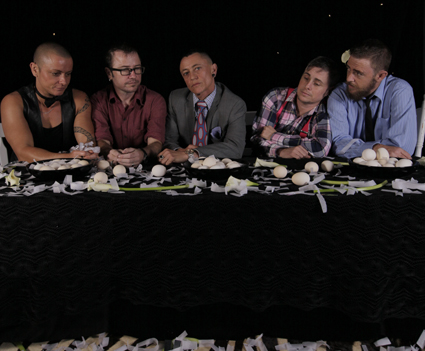To be different, visible and invisible
Keith Gallasch: ACP, We Are Family

Deborah Kelly, from The Miracles, 2012 courtesy Gallery Barry Keldoulis and courtesy and © the artist
In a concept bending exhibition, photographer C Moore Hardy as curator brings together six female artists to celebrate the changing nature of the family by juxtaposing the heterosexual, gay, lesbian, bisexual, transgender, queer and intersexual (GLBTQI) families.
Quietly exhilarating major works by r e a and Deborah Kelly convey a sense of calm and joy—of new family models firmly in place. Waded’s three portraits of a lesbian couple and child simply express the three relationships inherent in one family. Michelle Aboud’s trio of portraits of middle-aged women with their gay adult children likewise confirms a sense of harmony, here between generations. Aboud’s ultra-sharp naturalism conjures near hyperreal presences—celebration writ large with laughter, intimacy, animation, reflection and, not least, a sense of perfection, digitally precise but warm.
Deborah Kelly’s The Miracles is an inherently provocative but gently realized take on The Immaculate Conception. Across a long wall and at various heights, a host of small images—photographs referencing Renaissance Virgin and Child paintings—in antique tondo (round) wooden frames demand close scrutiny. For a moment you feel as if you’ve wandered into a state art gallery, but where there were paintings, now there are photographs in which the holy family has been displaced by various groupings—same sex, hetero, single parent and larger indeterminate gatherings—each focused on a child, save for a few solo adult portraits. You think you know what The Miracles is about until the room notes bring it home: “All the children in the photographs were conceived through various Assisted Reproductive Technologies (ART).”
With photography and lighting by Alex Wisser, Kelly has meticulously staged the groupings in the manner of Renaissance paintings with carefully arranged, replicated poses, contrasting soft and firm colours, gentle lighting and alertness to the wrap and fall of clothing, amplified by the artist’s use of robes, long gowns, scarves and hoods without going too historical. God, however, is out of the picture. No benign rays shine from above, nor do angels hover. The miracle of The Immaculate Conception has become multiple: The Miracles, the kinds of families, many. Miracles are now scientific and liberationist, born of desire, defiance and activism.
In Scissus (from the Latin: scindere, to split, to bring forth), Annie Magdalena Laerkesen portrays a complex relationship between mother and child, triggered in part by the experience of a caesarean birth. There are two photographs, one small, featuring a smiling naked baby in bright red swaddling and holding aloft two tiny yellow pyramids. Several yellow threads run from this image to a large photograph to its left in which the naked mother draped in the same kind of cloth, holds a large yellow pyramid, altogether erasing her face. Although the symbolism of the objects is elusive, the work is disturbing and aesthetically engaging.

r e a, DTDFJ, 2014 courtesy and © the artist
In an intimate alcove, r e a’s two large, utterly arresting portraits of a group of five men (formerly women) constitute a subtle contrast in states of being. On the left, hands relaxed on the table, one man leaning gently against another, the group is serenely thoughtful. Only one looks out, directly at us, as a figure will so often do in classical painting. r e a herself notes the associations with The Last Supper and Judy Chicago’s The Dinner Party. Behind the men, sparse stars in a black sky. On the table, eggs in black bowls and on the dark tablecloth, alongside scattered lilies and tinsel. The latter has fallen to the floor in the photo, and the actual gallery floor. In the second portrait, the figures are smiling, physically animated, fully engaged with each other; the man who looks out at us in the first image does so again—but his raised hand indicates he’s happily partaking of the conversation before catching our eye. Again one body is amiably tucked into another. But this time, the scene is elemental—the life and death symbolism of eggs and lilies now stripped of glitter is stark, but no one cares, as these men enjoy the moment and their kin. r e a, says the room note, “is interested in opening dialogue about ‘what it might mean to be different, visible and invisible.’”
Hard to place in the familial context is The Twilight Girls’ Consider Her Ways in which a spectacular multi-headed, multi-breasted, mud-smeared Lilith (Adam’s first, unsubservient wife) is unambiguously a figure of horror in the B-grade movie manner. Otherwise We are Family is a gentle, contemplative experience with much to say about the evolution of social relationships.
We are Family, curator C Moore Hardy, photographers Michelle Aboud, Deborah Kelly, Annie Magdalena Laerkesen, r e a, the Twilight Girls, Waded; Australian Centre for Photography, 2014 Gay & Lesbian Mardi Gras, 1 March-18 May
RealTime issue #120 April-May 2014 pg. 24-25






